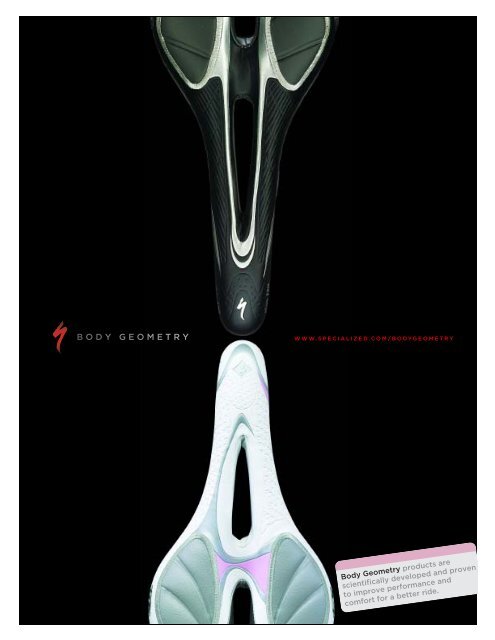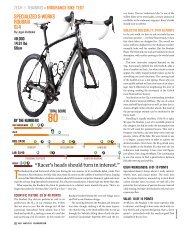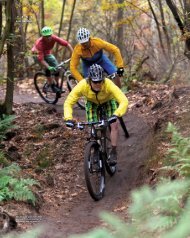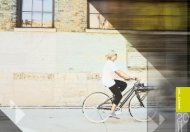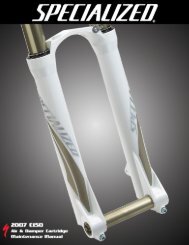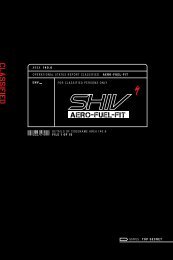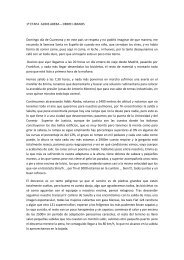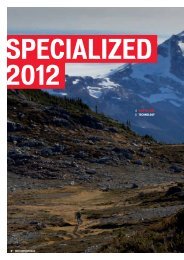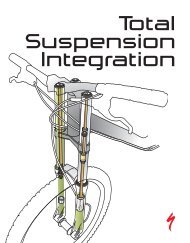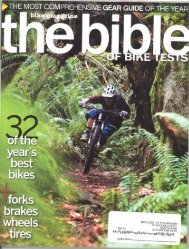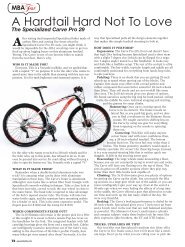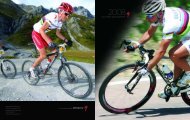Body Geometry products are scientifically developed ... - Specialized
Body Geometry products are scientifically developed ... - Specialized
Body Geometry products are scientifically developed ... - Specialized
Create successful ePaper yourself
Turn your PDF publications into a flip-book with our unique Google optimized e-Paper software.
WWW.SPECIALIZED.COM/BODYGEOMETRY<br />
<strong>Body</strong> <strong>Geometry</strong> <strong>products</strong> <strong>are</strong><br />
<strong>scientifically</strong> <strong>developed</strong> and proven<br />
to improve performance and<br />
comfort for a better ride.
<strong>Body</strong> <strong>Geometry</strong> saddles were conceived in 1997 to address the<br />
problem of Erectile Dysfunction related to disturbances in male blood<br />
flow while cycling on traditional bicycle saddles. <strong>Specialized</strong>'s founder,<br />
Mike Sinyard, enlisted the help of Dr. Roger Minkow, an ergonomics<br />
expert who had designed pilot seats for United Airlines, as well as<br />
weight training equipment for the US Olympic Gymnastics team.<br />
Minkow designed the first <strong>Body</strong> <strong>Geometry</strong> Saddle with a V-shaped<br />
cutout, theorizing an increased blood flow because of reduced<br />
pressure between the pubic bones. Minkow's premise was that the<br />
internal pudendal arteries (and nerves) were being compressed<br />
against the pubic bones by the dome of the traditional bicycle<br />
saddle. This theory was substantiated in the medical literature by<br />
Urologists, including Dr. Irwin Goldstein of the Boston Medical Center.<br />
After designing the initial <strong>Body</strong> <strong>Geometry</strong> Saddle, prototypes were<br />
sent out for testing by both athletes and media, including writers<br />
from Bicycling Magazine. The tests were very positive and in<br />
September 1998, the first <strong>Body</strong> <strong>Geometry</strong> Saddle was given the<br />
highest award that Bicycling Magazine gives for <strong>products</strong>.<br />
Figure 1: TcO2 correlates with penile blood flow measured by Doppler<br />
In 1997 there was no direct way to test male blood flow while a<br />
cyclist was actually riding a bicycle. The only tests available were<br />
stationary tests with the rider sitting on a bicycle saddle, or on a<br />
chair. These initial tests showed a clear decrease in blood flow while<br />
sitting on the bicycle saddle, but the relevance of the information<br />
was in question.<br />
BG | 1<br />
BODY GEOMETRY<br />
STORY<br />
BACKGROUND<br />
AND TIMELINE<br />
WWW.SPECIALIZED.COM/BODYGEOMETRY<br />
The first field test of the initial <strong>Body</strong> <strong>Geometry</strong> concept was held at<br />
The Great Tour of Strength in Norway, a 540km single-stage race.<br />
The incidence of ED at this event in years past was published in<br />
ACTA Scandinavia in 1997 and shown to be 13%. Because of the medical<br />
data derived from this race, Minkow chose this as the first testing<br />
ground for the BG Saddle. Riders given BG saddles to use during the<br />
race were found to have a lower rate of ED, as well as a decrease in<br />
observed perineal numbness.<br />
In the years that followed, more efforts were focused on finding a<br />
more quantifiable method by which effectiveness could be measured.<br />
It was in 2000 that Dr. Frank Sommer, a German Urologist, <strong>developed</strong><br />
the first method of measuring internal pudendal blood flow while<br />
cycling. He measured the blood flow in the arteries using a Dopler<br />
Duplex device and correlated this with Transcutaneous Oxygen<br />
measured at the Glans of the Penis, establishing a direct correlation<br />
between the two. Dr. Sommer then perfected testing Transcutaneous<br />
Oxygen by gluing a plastic ring on the Glans, filling the ring with fluid<br />
and measuring the Oxygen concentration in the fluid while riding.<br />
This led to exact measurement of the Internal Pudendal Blood Flow<br />
in real time: the first actual riding tests that could accurately measure<br />
blood flow.<br />
Figure 2: Perineal compression during cycling appe<strong>are</strong>d to be responsible<br />
for some cases of Erectile Dysfunction (Sommer, Eur Uro Suppl. 1999)
Minkow first visited Dr. Sommer's laboratory in 2002, where he<br />
was able to measure the actual blood flow in the <strong>Body</strong><br />
<strong>Geometry</strong> Saddles. Using this data and numerous trips back<br />
with updated models and prototypes, Minkow altered the<br />
angles of the cutouts, the densities of the polyurethane foam,<br />
and the placement of the window in the front section of the<br />
saddle. By this, Minkow was able to maximize the rider's blood<br />
flow on each saddle.<br />
Figure 3: Saddle<br />
design and Penile<br />
Blood Flow<br />
(Sommer:<br />
European<br />
Urology 41,<br />
2002)<br />
Since then, Minkow has tested every BG saddle design in Dr. Sommer's<br />
laboratory and has continued to optimize the shapes of the saddle<br />
itself, the shapes of the cutouts, the position of the window, and<br />
padding density. While blood flow in non-BG saddles has been<br />
measured at levels as low 5%, BG saddles have measured up to 100%<br />
in published comparison tests in German Cycling magazines.<br />
BLOOD FLOW<br />
COMPARATIVE RESULTS<br />
Tour Magazine. In April, 2004 Tour Magazine (Germany) performed<br />
tests on a number of saddle designs of their choosing. Note that this<br />
test and the those subsequently performed by Mountain Bike<br />
(Germany) were done in a “enthusiast” riding position on a road bike<br />
with that the rider's hands on the brake hoods. (This 60° position is<br />
also equivalent to most enthusiast rider's hands on the grips of XCclass<br />
mountain bikes.) The test results shown here were done with a<br />
volunteer Tour editor as the test subject. Although different riders<br />
will tend to show different results, Dr. Sommer confirms these values<br />
<strong>are</strong> typical and that the percentage values <strong>are</strong> representative of his<br />
results with the other test subjects.<br />
Source: testing conducted with Tour magazine editor, April 2004.<br />
Comparison samples of racing and/or anatomic saddles selected and<br />
provided by Tour magazine. Results in order of performance.<br />
Stabilized Blood<br />
Saddle Brand and Model Flow Value1 <strong>Specialized</strong> BG Pro Road 89.3%<br />
Terry Fly Max 75.8%<br />
SQ Lab 611 72.6%<br />
Selle Italia SLK Gel Flow 71.6%<br />
AX Lightness 65.9%<br />
Selle Italia SLR 65.4%<br />
Selle Italia Flite 65.1%<br />
Selle San Marco Arrowhead 54.3%<br />
Selle San Marco Aspid FX 53.3%<br />
SDG USA 52.7%<br />
WRC1 Extreme 50.0%<br />
Tune Speed Needle 41.4%<br />
Fizik Alliante 40.3%<br />
Fizik Vitesse 39.6%<br />
SaddleCo 36.2%<br />
Terry Butterfly RS Women 32.8%<br />
Fizik Arioni 27.5%<br />
Selle San Marco Rolls 6.5%<br />
1 After five minutes’ cyling at a comfortable pace.<br />
WWW.SPECIALIZED.COM/BODYGEOMETRY<br />
BG | 2
Additional independent studies were done by Mountain Bike<br />
Germany based on the new blood flow measurement techniques,<br />
showing a wide array of saddles measured against each other.<br />
FURTHER TESTING<br />
In May 2004, Dr. Minkow conducted supplemental tests in the<br />
more aggressive 30° “racing” or “aero” (rider with hands on the<br />
dropped part of a road bar, equivalent to an extreme XC MTB<br />
racing) position. Previous studies had found this position restricted<br />
blood flow significantly more than the neutral (on the brake<br />
hoods) position.<br />
BG | 3<br />
WWW.SPECIALIZED.COM/BODYGEOMETRY<br />
In addition, five different racing and/or anatomic-type saddles<br />
were chosen and a test rider cycled for seven minutes in the aero<br />
or race position. The results were as follows:<br />
Saddle Brand and Model Stabilized Blood<br />
Flow Value<br />
BG Avitar (2005 road racing model) 54%<br />
Selle San Marco Aspid 35%<br />
Selle Italia Flite 25%<br />
Selle Italia SLK 25%<br />
Selle Italia SLR 9%<br />
We now have a far more complete view of effectiveness, thanks to<br />
these new testing methods. As a result, <strong>Body</strong> <strong>Geometry</strong> saddles<br />
address all aspects of ergonomics, by accounting for not just<br />
perceived comfort, but also <strong>scientifically</strong>-documented men's and<br />
women's-specific pressure relief requirements. Additionally, <strong>Body</strong><br />
<strong>Geometry</strong> saddles do so without forcing a rider to compromise their<br />
personal requisite levels of saddle performance: BG technology and<br />
benefits <strong>are</strong> available in models to suit recreational riders and<br />
professional racers alike.
DESIGN ASPECTS<br />
COMFORT<br />
MATERIALS<br />
The most obvious and most common method of achieving comfortable<br />
saddle designs is the c<strong>are</strong>ful use of different materials. However,<br />
addressing comfort issues by simply increasing the amount of<br />
padding is r<strong>are</strong>ly effective, and sometimes can even be detrimental<br />
to comfort and safety. In fact, in January 2004, in Drs. Sommer and<br />
Minkow's first presentation of their blood flow laboratory protocol to<br />
journalists, <strong>Body</strong> Gometry saddles were comp<strong>are</strong>d to even thickly<br />
padded saddles, and it was found that the softest, most padded saddles<br />
restricted blood flow more than any other type of saddle. Every<br />
<strong>Specialized</strong> <strong>Body</strong> <strong>Geometry</strong> saddle utilizes unique blends of multidensity<br />
foams and, strategically located gel pads, and advanced<br />
composite bases engineered to have specific levels of flex to suit the<br />
saddle. Optimal use of each of these materials aids comfort and can<br />
contribute to the design of an ergonomic saddle, but materials alone<br />
<strong>are</strong> insufficient - the design itself must be ergonomic, and the materials<br />
must be utilized to support that design.<br />
WIDTH<br />
Men and women who ride bicycles <strong>are</strong> all different sizes. When sitting<br />
on the bicycle, the pelvic sit bones (ischial tuberosities) contact the<br />
saddle. As the rider's pelvic width increases, the rider generally needs<br />
a wider saddle. Likewise if the pelvis is narrower, the saddle that the<br />
rider feels comfortable may be narrower. However, the dimension of<br />
the pelvic bones has absolutely no relationship to the dimensions of<br />
the rider (Height, weight, etc.). The only way to understand the<br />
pelvic width and therefore determine the correct width saddle to ride<br />
is to measure the ischial tuberosities. This is done with a special<br />
measuring tool <strong>developed</strong> by Carl Bird of <strong>Specialized</strong>. Riding position<br />
for both men and women also plays a factor. The more aerodynamic<br />
a riders position, the narrower the pelvic contact, since the pelvic<br />
bones <strong>are</strong> in the shape of a triangle with the wider part in the rear.<br />
Men's and Women's saddles created by <strong>Specialized</strong> now come in different<br />
widths so that riders can choose the most comfortable as well<br />
as the most medically safe saddle for their needs.<br />
WIDTH TESTING<br />
During blood flow testing, varying the width of the saddles created<br />
differing percentage of blood flow for male cyclists. Theoretically this<br />
is due to the difference in width of the pelvic bones: when comparing<br />
similar body types and sizes, women's sit bones <strong>are</strong> typically 1 cm<br />
wider than men's. With wider pelvic bone separation, the distance<br />
between the ischial tuberosities (sit bones) increases, requiring a<br />
wider saddle for support. If a rider with wider sit bones sits on a narrow<br />
saddle, the rider is not well supported and the saddle pushes up<br />
into the pelvis, compressing the internal pudendal arteries which lie<br />
in Alcock's canal against the pelvic wall. During women's testing,<br />
saddle widths changed the pressure map as well as the maximum<br />
pressure felt by the rider. Women with wider sit bones had less pressure<br />
with a wider saddle even though the central cutout and window<br />
remained identical.<br />
PRESSURE RELIEF<br />
With respect to the pressure saddles create, and the designs that can<br />
alleviate this pressure, men and women both have very unique<br />
requirements. Male cyclists have been shown to have an increased<br />
incidence of Erectile Dysfunction as a result of riding, something<br />
that's been shown to be true in hundreds of studies since 1984. The<br />
ED has been associated with constriction of the Internal Pudendal<br />
arteries in the region of Alcock's Canal, attached to the pubic bones<br />
of the pelvis. Female cyclists have been shown to have pain, numbness,<br />
urinary, and sexual problems as a result of riding. This is<br />
thought to be the result of both constrictions of the arteries (just as<br />
with male cyclists), as well as direct perineal pressure from the bicycle<br />
saddle.<br />
WWW.SPECIALIZED.COM/BODYGEOMETRY<br />
BG | 4
MEN<br />
Through our studies, we now have a clear picture of the health and<br />
physiological impacts of bicycle saddles on male cyclists, specifically<br />
as it relates to the compression of the pudendal arteries. Because we<br />
can now accurately measure blood flow in male cyclists, we can<br />
accurately comp<strong>are</strong> different saddle designs, and utilize this data to<br />
improve and optimize each BG saddle for its intended use.<br />
MEN'S BLOOD FLOW TESTING<br />
In January 2004, Drs. Sommer and Minkow presented their blood<br />
flow laboratory protocol to journalists from the USA and Europe. This<br />
presentation comp<strong>are</strong>d general types of saddles including soft, thickly<br />
padded traditional saddles, conventional race-type saddles, and socalled<br />
“anatomic” saddles designs. In comparing these general types<br />
of saddles, the journalists noted some surprising overall results that<br />
remained consistent regardless of the brands of saddles tested:<br />
• Soft, padded saddles restrict blood flow more than any other type.<br />
In general, the more padding, the more restriction.<br />
• Thinly padded racing saddles, while clearly less comfortable for<br />
most cyclists, performed better than soft “comfort” saddles in<br />
terms of blood flow.<br />
• Overall, anatomic saddle designs (with grooves, cut-outs, or<br />
relieved <strong>are</strong>as), offered the best performance (restricted blood<br />
flow the least).<br />
BG | 5<br />
PRESSURE RELIEF NEEDS ARE DIFFERENT<br />
FOR MEN AND WOMEN<br />
Women's perineal pressure is related to the anatomy of the perineum (<strong>are</strong>a between the clitoris and anus).<br />
The cutout on the women's saddle is hour glass shaped as opposed to the V cut in the men's saddles. This<br />
specific difference in cutout shape is responsible to decrease in direct pressure for women. Because their sit<br />
bone width is wider than men's, only women with small sit bone width who ride predominantly in the aero<br />
position will require the narrowest saddle.<br />
Comfort saddles for women, ie. The Dolce, <strong>are</strong> deliberately wider because of the sit bone width increase in<br />
women. This saddle is also wider because it is presumed that women on this type of saddle will ride in a<br />
more upright position. Because the pelvic bones <strong>are</strong> widest in the rear or when the rider is upright, the<br />
saddle needs to be wider than a higher performance saddle which assumes a more forward leaning position.<br />
Blood flow for men is restricted in two places on the bicycle saddle, in the rear 1/3 of the saddles where the<br />
internal pudendal arteries <strong>are</strong> compressed in the vicinity of Alcock's canal, and under the symphysis pubis<br />
(front connection of the pelvic bones). The placement of the V cut takes into account the rear constriction<br />
and the window in the front alleviates the compression under the symphysis.<br />
WWW.SPECIALIZED.COM/BODYGEOMETRY<br />
Editors from various magazines then requested comparison tests<br />
between different saddles available in the marketplace (samples were<br />
provided by the editors). Dr. Sommer outlined the complexity of<br />
doing comparison tests in the following way:<br />
1. Each rider has a different baseline blood flow. Some riders have<br />
inherently higher blood flow (probably because of anatomical<br />
differences).<br />
2. Temperature affects rider's blood flow so that on different days<br />
the same rider may have different results.<br />
3. Different riders have more sensitivity to arterial constriction, so<br />
that in some cases a rider will sit on a saddle and the arteries<br />
immediately constrict, then expand to give a baseline blood flow<br />
that is stable after several minutes.<br />
• Other riders will have less immediate drop and stabilize faster.<br />
• In almost all cases, blood flow stabilizes between the 5 and 7<br />
minute mark.<br />
4 Anatomical differences exist so that a particular saddle may<br />
provide one rider with more blood flow than a different-sized rider.<br />
Dr. Sommer emphasized that while more blood flow is obviously<br />
better, any value of more that 50% is reasonable to consider safe for<br />
most cyclists.
WOMEN<br />
Women cyclists have not yet been studied to the extent that men have.<br />
While there <strong>are</strong> hundreds of medical studies linking men's problems and<br />
bicycling, there is only one study describing women's problems, written<br />
by Dr. Irwin Goldstein's group in Boston. In the study they attribute pain,<br />
numbness and sexual dysfunction in women cyclists as being a result of<br />
direct pressure from the saddle.<br />
In an effort to create more comfortable and safe saddles for women,<br />
Minkow studied women cyclists at The Boulder Center of Sports Medicine.<br />
The riders inserted TekScan sensors in their cycling shorts to accurately<br />
measure perineal pressure in the sensitive soft tissue <strong>are</strong>as. These measurements<br />
showed enormous differences between saddles and showed<br />
that the <strong>Specialized</strong> saddles had in many cases 1/4 the pressure of the<br />
competition.<br />
The issue of women's saddles has not been able to be addressed using<br />
blood flow measurement, because thus far there has been no physical<br />
way to attach the Oxygen measuring device to the vaginal wall. In<br />
2005, Minkow devised a testing method to show direct pressure on the<br />
women's anatomy. Using TekScan sensors placed inside the shorts of<br />
women volunteers, pressure on the soft tissue was measured while riding.<br />
Perceived pain was directly correlated with increase in pressure on<br />
a colored pressure map, allowing saddle design to be correlated with<br />
pressure mapping. BG women's saddles showed in some cases only 1/4<br />
the pressure of traditional saddles in the perineal <strong>are</strong>a.<br />
WWW.SPECIALIZED.COM/BODYGEOMETRY<br />
BG | 6
PERFORMANCE<br />
Experience driven designs<br />
In addition to the advanced <strong>Body</strong> <strong>Geometry</strong> design elements, each<br />
saddle is <strong>developed</strong> to suit specific types of riders and environments,<br />
based on the experience that any rider is seeking.<br />
Toupe: Competitive Road, Track<br />
Alias: Competitive Road, Track<br />
Avatar: Endurance Road, Ergonomic Road,<br />
Fitness/Commute<br />
Rival SL: Competitive XC, Freeroad<br />
Rival: XC Trail, Aggressive ATB<br />
Indie,<br />
Indie Sport: XC Trail, Aggressive ATB, Freeroad,<br />
Ergonomic Road<br />
Jett Women's: Women's Road, Women's ATB<br />
Dolce,<br />
Dolce Gel: Women's Road, Women's ATB, Women's<br />
Comfort<br />
BG2 Sport: Comfort Street, Comfort ATB<br />
Milano,<br />
Milano Gel: Comfort Street, Comfort ATB<br />
BG Comfort,<br />
BG Comfort Plus: Comfort Street, Comfort ATB<br />
WEIGHT & MATERIALS<br />
Every BG saddle blends a range of optimal materials and construction<br />
methods to achieve optimal levels of comfort, weight, and durability -<br />
again, factors that <strong>are</strong> dictated by the experience that the intended<br />
rider is seeking. Competitive riders will appreciate the unparalleled<br />
weights we achieve utilizing carbon fiber shells, hollow titanium rails,<br />
micromatrix synthetic cover materials, and ultralight thin-profile foam<br />
padding. Those seeking added comfort on longer rides will find<br />
solace in our judicious use of gel padding on select models, putting<br />
further damping and shock absorption between the rider and the<br />
road or trail. Women will appreciate our unique padding shapes and<br />
densities, available in a range of models to suit nearly any female<br />
cyclist. And those seeking greater comfort and shock absorption for<br />
more recreationally-focused riding will appreciate the BG models that<br />
utilize denser padding and additional gel inserts, maximizing comfort<br />
for those who value it most.<br />
Roger Minkow, MD<br />
Roger Minkow is a medical doctor who began<br />
designing ergonomic <strong>products</strong> in 1984. At that<br />
time he designed the workout equipment for the<br />
US Olympic Gymnastics team, and then went on<br />
to design the pilot's seats for United Airline's<br />
767's in 1988. During this time he was the Co-<br />
Medical Director of the San Francisco Spine<br />
Center and a medical researcher in the field of<br />
Spinal Surgery. Dr. Minkow began working with<br />
<strong>Specialized</strong> in 1997.<br />
Since then, he has designed the ergonomic components<br />
for the <strong>Body</strong> <strong>Geometry</strong> Saddles, Gloves,<br />
and Grips. Together, <strong>Specialized</strong> and Dr. Minkow<br />
have revolutionized and re-educated the cycling<br />
industry towards a more <strong>scientifically</strong>-grounded<br />
approach to component and app<strong>are</strong>l design.<br />
WWW.SPECIALIZED.COM/BODYGEOMETRY<br />
BG | 7


